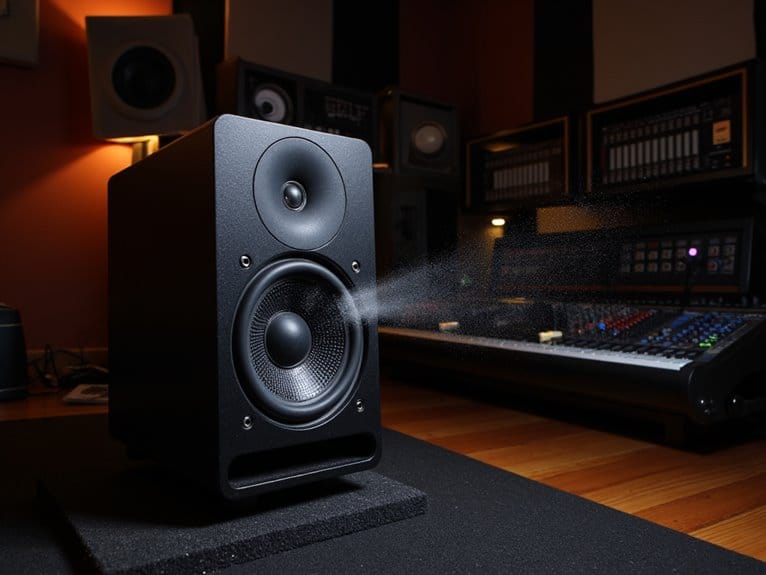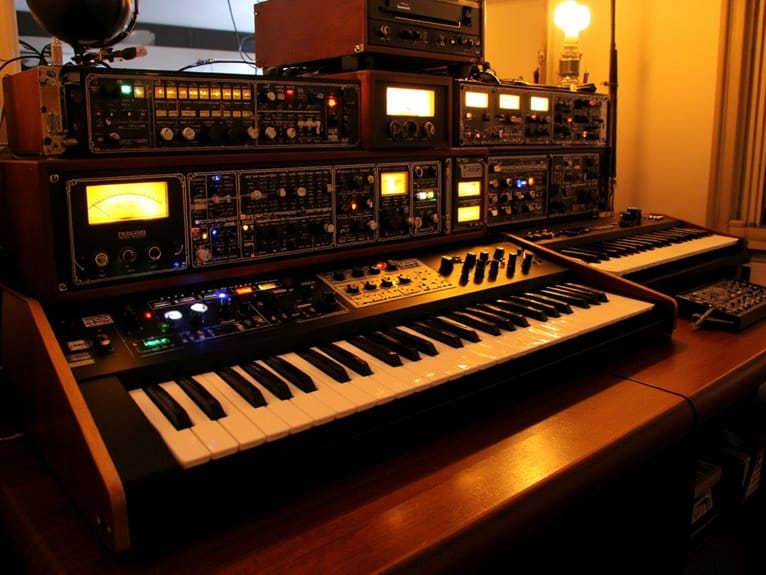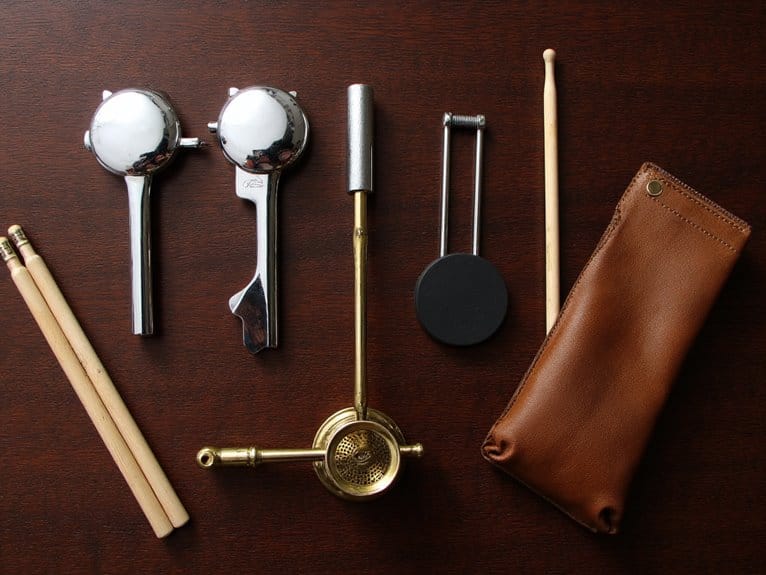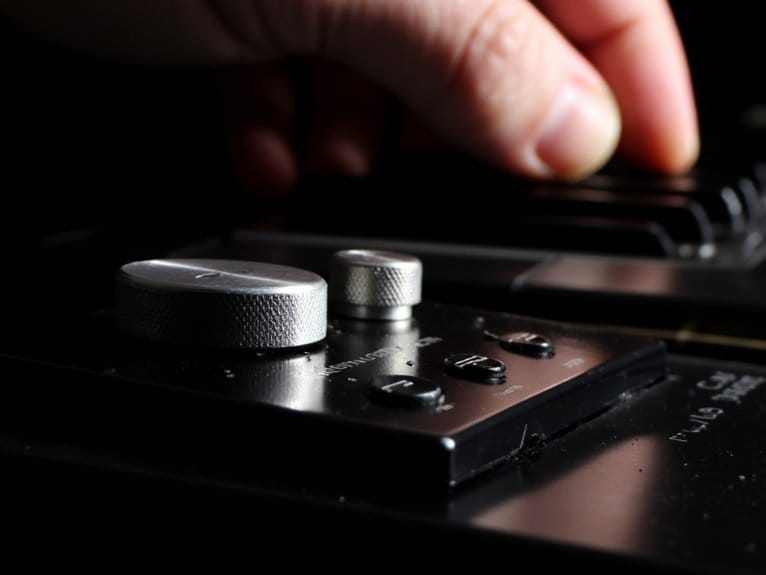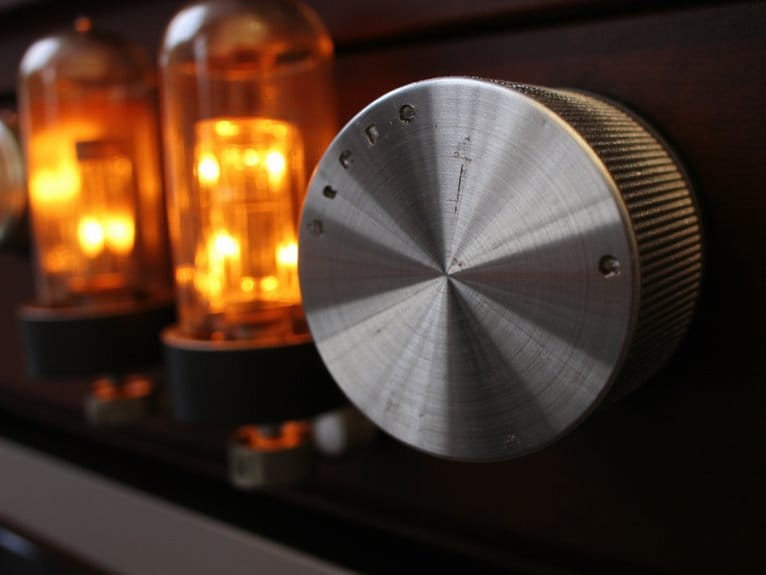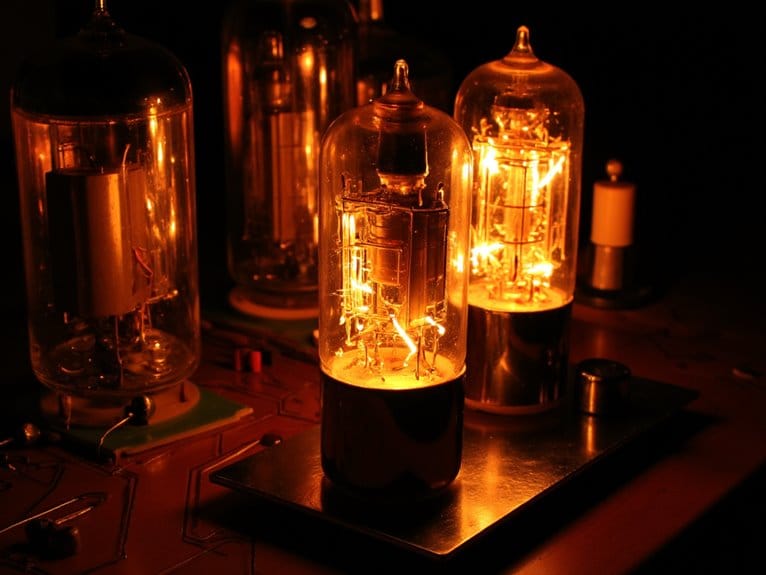Understanding Studio Monitor Frequency Response and Accuracy
Understanding studio monitor frequency response means grasping how accurately your speakers reproduce each frequency from 20 Hz to 20 kHz, with flat response being essential for uncolored monitoring that prevents mixing overcompensation. You’ll find budget monitors typically cover 45 Hz to 20 kHz while premium models extend deeper and higher, with ±3 dB tolerance specifications indicating better accuracy, though manufacturers often omit these numbers to enhance perceived performance, and mastering these fundamentals will transform your mixing approach.
We are supported by our audience. When you purchase through links on our site, we may earn an affiliate commission, at no extra cost for you. Learn more.
Notable Insights
- Flat frequency response ensures all frequencies play at equal volume levels, preventing mix colorations and overcompensation during audio production.
- Frequency range varies by budget: entry monitors cover 45Hz-20kHz while premium models extend to 39Hz-40kHz for enhanced accuracy.
- Driver materials, enclosure design, and tweeter types directly influence frequency response characteristics and overall monitoring accuracy.
- Built-in EQ allows engineers to compensate for room acoustics and optimize frequency response in various studio environments.
- Consistent monitoring at 73-76 dB SPL prevents perception shifts and maintains accurate frequency balance throughout mixing sessions.
What Frequency Response Means and Why Specifications Matter
When you’re shopping for studio monitors, the frequency response specification acts like a roadmap that reveals how faithfully your speakers will reproduce every note, drum hit, and vocal nuance across the entire audible spectrum.
Unlike frequency range, which simply tells you the span of frequencies your monitors can handle, frequency response shows amplitude variations at each frequency, typically displayed as a curve graph that manufacturers provide alongside their specifications.
Here’s where tolerance significance becomes essential—when you see “20 Hz to 20 kHz ±3 dB,” that tolerance figure determines how much deviation you’ll experience from flat response across that range, directly affecting your mixing accuracy and the reliability of your production decisions in professional studio environments. Some manufacturers deliberately avoid stating tolerance to make their products appear more capable than they actually are, which can mask significant peaks and dips in the actual frequency response performance.
The complexity of converting electronic signals into acoustic energy means that achieving perfectly flat response requires overcoming significant material limitations that affect driver diaphragm performance across the full 20 Hz to 20 kHz bandwidth.
The Critical Role of Flat Response in Professional Audio Monitoring
The foundation of professional audio production rests on one fundamental principle: what you hear through your studio monitors must represent the unvarnished truth of your recordings, without the flattering lies that consumer speakers tell through boosted bass and sparkly highs.
When you’re working with accurate monitoring, every frequency plays back at equal volume levels, giving you the neutral reference point that’s essential for making informed mixing decisions. This flat response prevents you from overcompensating for monitor colorations, which would create mixes that sound off-balance on other playback systems.
Professional monitors prioritize faithful reproduction over entertainment value, allowing you to achieve mix consistency across diverse listening environments while developing the critical listening skills necessary for quality audio production. Unlike Hi-Fi speakers that emphasize certain frequencies to enhance the listening experience, studio monitors maintain neutral sound to prevent misrepresentation during the mixing process.
Frequency Range Variations Across Different Monitor Models
When you’re comparing studio monitors across different price points and manufacturers, you’ll quickly notice that frequency range specifications vary dramatically, with budget models typically covering 45 Hz to 20 kHz while premium monitors can extend from 40 Hz down to as low as 39 Hz and reach up to 40 kHz on the high end.
The low-frequency extension differences become particularly apparent when you’re mixing bass-heavy material, as cheaper monitors with 54 Hz lower limits will miss vital sub-bass information that more expensive models with deeper extension can reproduce accurately.
Similarly, high-frequency ceiling variations affect your ability to hear subtle details in cymbals, reverb tails, and harmonic content, since budget tweeters often roll off around 20 kHz while advanced ribbon or dome designs in premium monitors can faithfully reproduce frequencies well beyond human hearing range.
Low-End Extension Differences
Most studio monitors don’t reproduce the same range of low frequencies, and I’ve found that understanding these differences can make or break your mixing decisions.
Your monitor design directly impacts bass reproduction capabilities, with woofer size being the primary determining factor. Compact monitors with 3″ to 4.5″ drivers typically extend down to 45-67 Hz, while mid-sized 5″ to 7″ woofers reach 40-50 Hz, and larger 8″ drivers can achieve 35 Hz or lower.
I’ve noticed that entry-level models often sacrifice low-end extension for affordability, cutting off around 50-80 Hz, whereas higher-priced monitors deliver wider frequency response.
If you’re working with bass-heavy genres, you’ll likely need larger drivers or subwoofers to compensate for smaller monitors’ limitations in deep bass reproduction.
Professional studio monitors typically aim for a flat frequency response from 40Hz to 20kHz to ensure accurate sound reproduction across the full spectrum.
High-Frequency Ceiling Comparisons
While bass extension varies dramatically between monitor sizes, I’ve discovered that high-frequency ceilings present an equally important yet often overlooked consideration in monitor selection. Your choice affects everything from transient response to overall clarity, though I’ll admit the differences between 30kHz and 40kHz remain largely theoretical since human hearing tops out around 20kHz.
High frequency design and tweeter impact create measurable differences in monitor performance:
- Frequency ceiling ranges – Models like the Focal ST6 Twin6 reach 40kHz while Kali Audio LP-6 stops at 25kHz, affecting ultrasonic detail reproduction.
- Tweeter technology variations – Ribbon designs provide more pristine extension than conventional dome tweeters, enhancing sound detail.
- Power distribution balance – Bi-amplified designs with proper tweeter wattage maintain clarity at higher volumes without distortion. Professional monitors designed for critical listening typically incorporate 24-bit/192kHz resolution converters to capture the full range of audio detail that these high-frequency capabilities can reproduce.
Professional monitors like the EVE Audio SC205 utilize proprietary AMT RS1 tweeter technology to achieve enhanced clarity and detail in their frequency reproduction capabilities.
Design Elements That Shape Frequency Response Performance
The physical architecture of studio monitors represents a complex interplay of engineering decisions that directly dictate how faithfully they’ll reproduce your audio across the frequency spectrum. Your monitor’s cabinet design, crossover networks, and driver alignment work together to create the final frequency response you’ll hear.
| Design Element | Impact on Frequency Response |
|---|---|
| Woofer materials | Cone stiffness affects transient accuracy and bass tightness |
| Tweeter types | Dome vs. ribbon designs influence high-frequency extension |
| Enclosure types | Sealed vs. ported affects low-end rolloff characteristics |
| Power handling | Amplifier matching prevents compression artifacts at volume |
Understanding these relationships helps you choose monitors that match your mixing needs, since acoustic dispersion patterns and crossover implementation greatly influence how accurately you’ll hear frequency balance in your studio environment. Professional studio setups often pair monitors with audio interfaces that provide the clean signal path necessary for accurate frequency response evaluation during mixing and mastering sessions. Active monitors with built-in EQ options provide additional control over frequency response tuning, allowing engineers to compensate for room acoustics and achieve more accurate monitoring in various studio environments.
How Sound Pressure Levels Interact With Frequency Accuracy
Beyond the physical design elements that shape your monitors’ capabilities, sound pressure levels create a dynamic relationship with frequency accuracy that I’ve found many engineers overlook until they’re knee-deep in problematic mixes.
Sound pressure levels control frequency perception in ways that catch experienced engineers off-guard during critical mixing decisions.
SPL fluctuations directly affect how you perceive frequency balance, with psychoacoustic influence making bass frequencies seem weaker at lower volumes while treble becomes less pronounced. This creates the illusion of frequency response problems when your speakers are actually performing correctly.
Here’s what you need to understand about SPL’s impact on frequency perception:
- Calibrate to 73-76 dB SPL (C-weighted) for home studios under 142 cubic meters to maintain accurate frequency judgment.
- Use consistent monitoring levels throughout sessions to prevent ear fatigue and perception shifts.
- Recognize equal loudness contours affect how frequencies translate between different playback volumes.
Reading and Interpreting Frequency Response Measurements
Accurate monitoring becomes meaningless if you can’t properly interpret the data that reveals how your speakers actually perform.
I’ve watched countless engineers make costly decisions based on frequency response graphs they’ve misunderstood or measurement techniques that introduced more confusion than clarity.
When you’re analyzing frequency response graphs, you’ll see amplitude plotted vertically in dB against frequency horizontally from 20 Hz to 20 kHz, and that flat line you’re hoping for indicates neutral reproduction across the audible spectrum.
Peaks show frequency boosts while dips reveal cuts, both creating unwanted colorations in your mix.
I recommend using 1/3 octave smoothing to visualize trends without getting lost in rapid fluctuations, and always compare your left and right channels to guarantee proper stereo imaging consistency.
Frequently Asked Questions
Can Room Acoustics Affect My Studio Monitor’s Frequency Response Accuracy?
Yes, your room’s acoustics markedly impact your monitors’ frequency response accuracy. Wall reflections create peaks and nulls, while poor room treatment and incorrect monitor placement cause coloration that makes reliable mixing nearly impossible.
Should I Choose Active or Passive Monitors for Better Frequency Response?
You’ll find active monitor advantages include built-in amplification optimized for drivers and simplified setup reducing frequency response errors. Passive monitor considerations involve external amplifier matching requirements and increased complexity that can affect accuracy.
How Often Should I Calibrate My Monitors to Maintain Accurate Frequency Response?
You should calibrate your monitors every 6-12 months for best monitor calibration frequency. Ideal calibration intervals depend on usage intensity—recalibrate quarterly for heavy use or before critical sessions to maintain accurate frequency response.
Do Expensive Monitors Always Have Flatter Frequency Response Than Budget Options?
You’ll find expensive monitors generally deliver flatter responses due to superior build quality, but some budget options can achieve impressive accuracy. Price differences don’t guarantee flatness—specific models matter more than cost alone.
Can I Fix Poor Frequency Response Using EQ or Room Correction?
You can partially fix frequency response issues, but EQ limitations include inability to correct timing problems and hardware flaws. Room correction software helps compensate for acoustic issues, though proper treatment remains essential for best results.
On a final note
You’ve now got the knowledge to evaluate monitor specifications with confidence, understanding that frequency response curves tell the real story behind marketing claims. When you’re comparing models, remember that perfectly flat response isn’t always achievable or necessary, but knowing how your monitors color sound lets you make informed mixing decisions. Trust your ears, but let science guide your studio investments.

